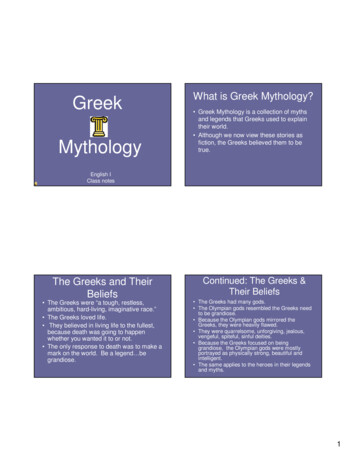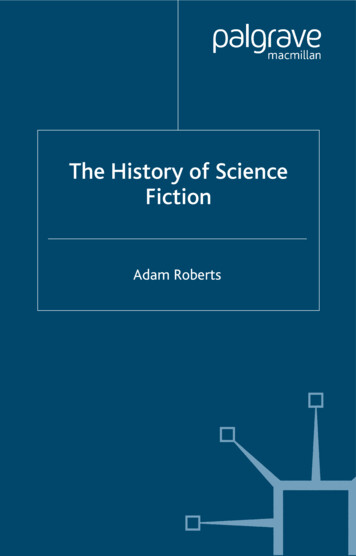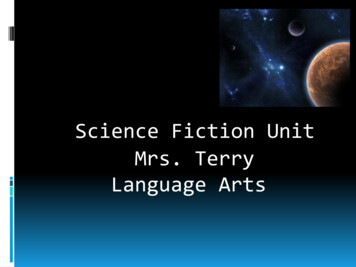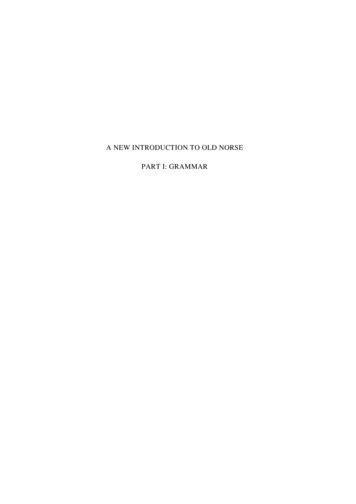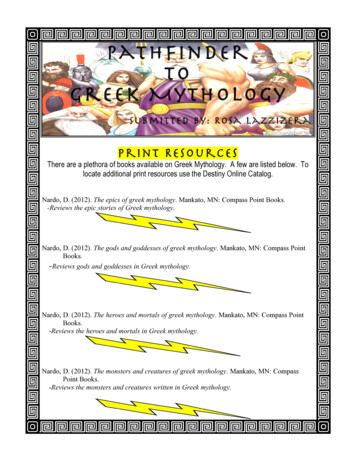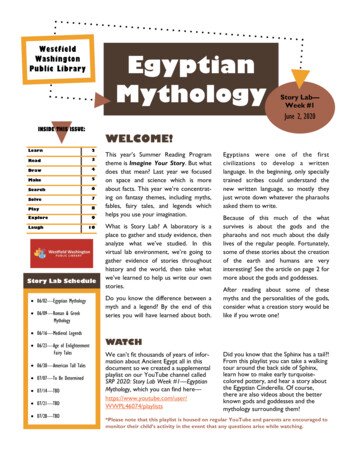
Transcription
Science Fiction as the Mythology of the Future“The universe is made of stories, not of atoms.”Muriel RukeyserIntroductionScience fiction is clearly the most visible and influential contemporary formof futurist thinking in the modern world. Why is science fiction so popular? As Iwill argue, one main reason for the popularity of science fiction is that itresonates with all the fundamental dimensions of the human mind and humanexperience. It speaks to the total person about the future.At the outset, let me provide a working definition of science fiction.Although not all science fiction deals with the future, its primary focus has beenon the possibilities of the future. In this regard, science fiction can be defined asa literary and narrative approach to the future, involving plots, story lines andaction sequences, specific settings, dramatic resolutions, and varied and uniquecharacters, human and otherwise. It is imaginative, concrete, and often highlydetailed scenario-building about the future set in the form of stories.In this chapter I describe the historical development of science fiction asan approach to the future tracing its origins to science and evolutionary theory,secular philosophy, technological forecasting, mythology, and the philosophy ofRomanticism.1 Within this historical review, I consider the rich array of futuristthemes and issues examined in science fiction. I also describe the diversefunctions and innumerable strengths of science fiction as a mode of futureconsciousness.My central arguments are: Science fiction engages all the fundamental capacities of the human mind;it generates holistic future consciousness. Of special note, science fictionintegrates the secular-rationalist and mythological-romantic approaches tothe future; it synthesizes the Dionysian and Apollonian mindsets regardingthe future. Science fiction weaves together theory and abstraction with personalizednarrative. It combines a highly detailed and concrete level of realism withtheoretical speculation on the future. Science fiction addresses all the main dimensions of the future andsynthesizes all these dimensions into integrative visions or scenarios ofthe future. Because it reflects contemporary and futurist thinking, and embodiesmany features of myth, science fiction can be viewed as the mythology ofthe future.Myth and Science Fiction
“ our aim is not merely to create aesthetically admirable fiction. We mustachieve neither mere history, nor mere fiction, but myth. A true myth is onewhich, within the universe of a certain culture expresses richly, and oftenperhaps tragically, the highest aspirations possible within a culture.”Olaf StapledonAs a starting point, I will consider the power of religion, and in particularreligious myth, as an approach to the future. Religious myth, though notexclusively focused on the future, has had a great impact on people’s beliefs andattitudes toward the future. It is the earliest recorded form and probably the mostinfluential type of futurist thinking. Predictions of the demise of religion and mythin modern times have proved inaccurate. The great bulk of humanity stillsubscribes to traditional religious doctrines, as well as various myths andprophecies associated with these doctrines. 2 After describing some of the mainfeatures of religious myth, I will demonstrate how science fiction embodies manyof the same qualities and strengths as religious myth.There are many explanations of the power of religious and mythic thinking.Religion answers the deepest metaphysical questions. It provides personalmeaning connecting the individual and social group with God’s purpose and withthe great narrative of history. Religious doctrines are usually connected withvarious myths which reinforce its belief systems and principles. Religious mythsexplain existence in the form of stories, connecting past, present, and future in away that is easily understood and highly inspirational. Often associated withreligious myths are ethical principles, providing ideals and direction for people intheir lives. Religious myths speak to the heart as well as the mind.There is an archetypal dimension of myth. An “archetype” is afundamental idea or theme often represented through some image, persona, orsymbol. Contained in various religious myths are such basic themes as deathand the renewal of life, honor and courage, love and devotion, temptation anddamnation, good versus evil, and creation. These central themes of humanexistence are often represented by mythological characters that provoke strongemotions in the believer and a sense of personal identification.Science fiction shares certain important commonalities and strengths withmyth. Just as with ancient myths, a key strength of science fiction is its narrativeform. It has become so popular because it appeals to the dramatic dimensionwithin people. Life seems more like a story than a set of abstractions, and just ashistory is a multi-faceted story, the future will be a complex saga of stories.Science fiction, like myth, contains personified characters, thus creating apersonal connection with the reader. The reader often identifies with thecharacters – sometimes positively, sometimes negatively - and vicariouslyexperiences the drama and events of the story through the characters.As with myth, the stories of science fiction express fundamental themesand archetypes of human existence. In both science fiction and mythology2
fantastic beings and settings are presented as a way to symbolically highlightimportant features of humanity or reality.Although science fiction may inform it also produces an emotionalexperience in the reader. The future is felt, as well as imagined and considered.This emotional dimension often translates into inspiration. As the science fictionwriter Thomas Disch argues, science fiction has become integral to our lifestyleand culture; through its characters, icons, stories, and themes, it inspires thereader and provides the raw material for turning the future into a personalizedjourney and way of life.3Although the experience of science fiction is personalized, science fictionstories are often set within a cosmic context and have the same breadth andscope that mythic tales do; they also address the same expansive themes of thenature of reality and the meaning of human existence. In fact, as in myth, sciencefiction connects the personal with the cosmic. What is the impact andsignificance of the unfolding cosmic events on the characters in the story?I think many science fiction writers are very conscious of the connectionbetween their genre and mythology. Many science fiction stories include ancientmyths, retold or re-conceptualized in futuristic settings One memorable story“Breckenridge and the Continuum” by Robert Silverberg is a good example of astory that explicitly combined both ancient myth storytelling with an eerie futuristlandscape and setting. In this story Silverberg examines the connection betweenmythology and the creation of the future and along the way creates a series ofnew myths for the future.4 In Harlan Ellison’s “The Deathbird” the story of theGarden of Eden and the temptation of Adam and Eve is retold. The nature ofgood and evil is re-examined, as is that of God and the serpent, this time thoughbeing played out in a far distant future that is witness to the end of the earth andmankind.5But science fiction goes beyond traditional myths. From a modernistperspective the myths of old are based on archaic thinking. They are oblivious tomodern science and the issues of modern life. If myths do have a unique powerto motivate and inform people, then perhaps what are needed are new mythsbased on contemporary thinking that address contemporary issues, as well asissues of the future.6 As I will argue, this is exactly what science fiction provides.It provides mythic tales informed by science and contemporary thought.Science and Science FictionI will now look at the relationship between science and science fiction. Iwill describe how science first impacted popular story telling in the modern era,and how this introduction of science into popular narrative led to science fiction.John Clute, in his Science Fiction: The Illustrated Encyclopedia, begins hishistory of science fiction by trying to define the distinguishing nature of sciencefiction. He notes that people from ancient times were writing fantasies of travelingto the heavens, or of encountering strange and fantastic beings in strange orfantastic places. Yet, according to Clute, the authors of these early stories did nottry to present a convincing case that their imaginative scenarios could actually3
exist in reality. Clute defines “fantasy” as “make-believe”, and argues that premodern fantasies were intended to be “make-believe” for they provided noexplanation of how the imagined fantasy could possibly be real. According tohim, the attempt to be realistic in such fantastic stories doesn’t occur until theScientific Revolution and the modern era. For Clute, More’s Utopia (1516),written prior to the modern era, was not intended to be a plausible or realsituation. On the other hand, Francis Bacon’s The New Atlantis (1626) wasintended to be a realistic possibility. Bacon attempted to explain how the type offuturist society he envisioned could be created through science and reason.Bacon offered a rich array of predictions of new and fantastic inventions andhuman realities for the future that presumably could be achieved through theapplication of science and reason. For Clute, Bacon’s The New Atlantis is ProtoScience Fiction.7Another early candidate for Proto-Science Fiction is Johannes Kepler’sSomium seu Astronomia Lunari (1634). According to Wyn Wachhorst, in theSomium, Kepler presented the first cosmic voyage in science fiction, involving ajourney to the moon. In this story Kepler was also the first person to seriouslyconsider the possibility of extraterrestrial life.8 For Kepler, space travel was not afantasy; he believed in the future we would journey into outer space. In Kepler’sown words, “Let us create vessels and sails adjusted to the heavenly ether andthere will be plenty of people unafraid of the empty wastes. In the meantime, weshall prepare for the brave sky-travelers maps of the celestial bodies.”Science and the concept of secular progress, associated with theemergence of the philosophy of the Enlightenment in seventeenth and eighteenthcentury Europe, provided a rationale and guide for conceiving of possible futuresfar different from the present. The idea of secular progress, briefly defined, is thathuman society can be improved, along many different dimensions, social andtechnological, through the application of science and reason.9 For Clute, thebeginnings of science fiction coincide with the emergence of the idea of secularprogress and the belief in realistically possible progressive changes in the futuredue to science and reason.Yet I would argue, contrary to Clute, that people in ancient times didbelieve in the existence of mythological places and beings. They believed thatgods and goddesses existed in a higher supernatural realm, though often theyvisited, haunted, or “enchanted” the natural world.10What changed in the modern era were the standards of knowledge andtruth. In Europe and elsewhere, in the pre-scientific era, truth was based uponfaith and belief in holy texts, as well as prophecies and divine revelations. Themetaphysical explanations of fantastic beings and alternate realities, justifiedthrough religious writings and mystical experiences, were not scientific or rationalby modern standards, and consequently, have been labeled as “superstitious”,and relegated to the realm of pure fantasy. According to its supporters andadvocates, modern science and the secular philosophy of the Enlightenmentencouraged freedom of thought and inquiry after centuries of religiousdogmaticism and repression. Answers to the fundamental questions of life couldno longer be grounded in faith, unsubstantiated authority, and sacred texts.4
Science in its pursuit of truth strove for objectivity and impartiality. Science basedits beliefs on empirical observation, experimentation, and reason, and thedescription of reality that emerged over the last few centuries within scienceclearly contradicted in many ways the description and explanation of realityoffered in ancient myths and religions.11Religious and mystical views of the future often saw humanity ascendingto supernatural realms. Christian thinkers such as St. Augustine believed that theforces of the supernatural or divine realm would transform the earthly realm as aprelude to ascension into a higher (heavenly) reality. St. Augustine imagined ourworld being modified to accommodate and fit with the spiritual realm. Theplausibility of this vision depended upon one’s standards of acceptable truth andthe nature of reality. For Augustine, it made perfectly good sense to argue thathumanity would be transformed in the future by the will of God.The emergence of science fiction as a form of narration about the futureinvolves a transformation in our standards of thinking, brought on by theScientific Revolution, regarding what is plausible and real. This new way ofviewing reality provided a different approach to understanding and predicting thefuture – an approach based on the ideas of reason and science. When the ageold tradition of story telling of strange and wondrous realities embraced the ideasand principles of science and secular progress as a way to explain its imaginativesettings and characters, science fiction was born.Hence, as can be seen, science fiction reflects many of the qualities andstrengths of ancient myth as well as the beliefs and standards of modernscience. It creates “scientifically credible” myths. Therefore, I propose thatscience fiction is becoming the mythology of the future. As ancient mythologiesprovided meaning and direction for humankind, I would suggest that sciencefiction, informed by science and contemporary and futurist thinking, will providethe stories that will give humanity meaning and direction in the future. Sciencefiction is usually about the future and serves the function of influencing ourjourney into the future. It will inspire us, as did ancient myths, but it will base itsvisions on contemporary ideas and standards.The Genesis of Science Fiction" . . . Frankenstein is the modern theme, touching not only science butman's dual nature, whose inherited ape curiosity has brought himboth success and misery."Brian Aldiss“It is possible to believe that all the past is but the beginning of a beginning, andthat all that is and has been is but the twilight of the dawn.It is possible to believe that all that the human mind has ever accomplished isbut the dream before the awakening.”H.G. Wells5
Science fiction also has roots in the Romantic philosophy of the nineteenthcentury. Nineteenth century literature was strongly influenced by Romanticphilosophy with its emphasis on human emotion and passion and the innerturmoil, madness, and distress of the human mind. In the nineteenth century,gothic, horror, and adventure stories, all expressions of the Romantic mindset,were very popular. One central goal of such stories was to stimulate and provokestrong emotional reactions in the reader, both positive and negative. Whereasthe emphasis in scientific writing has been to describe reality in an objective,rational, orderly, and non-emotional manner, Romantic writing often highlightedthe opposite qualities: subjectivity, mental turmoil, and emotionality.12Science fiction would combine together the Romantic - emotionaldimension of human experience with concepts and speculations derived fromscience and Enlightenment philosophy. Nineteenth century science fiction(before the genre had acquired its modern name) was popularly referred to as“scientific romances”. One early nineteenth century writer who wove togetherRomantic and scientific elements in his stories was Edgar Allen Poe (1809 –1849). Thomas Disch, in fact, argues that Poe is the modern starting point ofscience fiction. Poe is well known as a writer of horror stories and tales of thesupernatural, but he also includes various scientific ideas and speculations tocreate psychologically disturbing and mesmerizing effects in his dark tales.13The Romantic dimension of science fiction includes not only the terrifyingand horrific but the sublime and inspiring as well. As one early example, JulesVerne (1828 – 1905), highlighted the exhilarating and hypnotic power of newmachines and scientific devices, the exotic and esoteric realities and worldsuncovered or created through science and technology, the dramatic aweinspiring adventure into the unknown, the passion and excitement of exploration,and the existential and cosmic challenges of the future to the human soul.Another key connection between science fiction and Romanticism pertainsto the Romantic philosophical distrust, if not rejection, of the positive andprogressive promises of science, technology, and modernity. Though Cluteargues that futurist science fiction emerged when the hopes and predictions ofsecular progress were incorporated into popular story telling, stories withinscience fiction often have taken the opposite position. Science, secular progress,and the growth of technology may lead to our ruin.The classic case of this negative view of modern science and technologyis Frankenstein by Mary Shelley (1797 – 1851). Although during the nineteenthcentury there was great optimism about the future, perhaps the earliest exampleof a science fiction novel, Mary Shelley's Frankenstein, or the ModernPrometheus (1818), foretold of the potential dangers of science and technology.Shelley was aware of nineteenth century scientific experiments where animaltissue had been animated into movement through the passing of electricalcurrents through muscles. One night, in a personally frightening image, sheconceived of bringing a dead body back to life with electricity and thus the storyof Frankenstein was born.6
The main character in the story, Victor Frankenstein, after creating the“creature” immediately runs away from it, repulsed by its hideous appearance,and he abandons it. Throughout the novel, Frankenstein obsesses on howwretched and terrible a person he is for having produced the creature, and thecreature, rejected by his maker, as well as other humans he encounters in hiswanderings, decides to enact revenge on his creator through a series of ghastlymurders.14Frankenstein is fundamentally an introspective nightmare, more a critiqueof human nature than of science and technology.15 One could say that it was theegomania of Victor Frankenstein, coupled with his heartless abandonment of thecreature, that is the real cause of the misery, tragedy, and suffering described inthe novel. Shelley, in fact, does not discuss in any detail the technology ofcreating life or the potential problems of accelerating technology. Rather, shefocuses on Frankenstein the man, and the haunting thoughts and feelings thatliterally destroy him as the novel progresses.One actually feels more sympathy toward the creature than the man, forthe creature is innocent, having been brought into the world and then hated andrepulsed by all those around him. The creature even promises to leave the worldof humankind and live the rest of his life far from humans, if Frankenstein willcreate a female companion for him, but Frankenstein decides against creating acompanion, after first having agreed, and in so reneging on his promise,provokes the creature into murdering Frankenstein’s new bride.Still, in spite of the introspective quality of the story, due to itspopularization in the movies in coming years, the story of Frankenstein has beenstrongly associated with the potential dangers of technology, especially if it isused to serve the human aspiration to play God. Whether it is technology, assuch, or the human desire to gain power over reality through technology,Romantic philosophy saw problems and potential tragedy in putting too muchfaith and hope in science and technology. Frankenstein wanted to benefit theworld with his scientific research; he ended up destroying his life and bringingdeath and misery to all those around him. From the Romantic perspective, he isnot so much a “modern Prometheus” as he is a Faustian character having soldhis soul to the dual devils of vanity and technological power.The science fiction writer Brian Aldiss identifies Frankenstein as “themodern theme” for it not only addresses the dual nature of humanity, of being butan animal (an ape) yet God-like in power to understand and create; it alsoaddresses the double-edged sword of humankind’s superior powers. Accordingto Aldiss, the power to create brings both “success and misery”. Progress,technological and scientific, is a double-edged sword, and Frankenstein focusesupon the potential negative consequences of humanity’s increasing power overnature and the world. Aldiss, in fact, sees Frankenstein as a “new myth” – amodern myth for our times. Through science and technology humanity isbecoming God-like with the power to create, yet do we have the maturity andforesight to use this power wisely? With science having replaced God,humankind is empowered to remake the world. But Victor Frankenstein is a poorGod, a fearful God, for he recoils from his own creation, and dies a lonely death7
haunted by the reality of what he has brought upon the world.16 The tragic mythof Frankenstein, connecting humanity’s enhanced power to create with aninability to foresee the consequences of this new power and wisely nurture itscreations, is a common theme repeated throughout later science fiction. Thus,the first new myth created in science fiction is tragic and apprehensive over thefuture and the promise of scientifically inspired secular progress.Yet throughout the nineteenth century there were also many positivestories about the promises of technology, secular progress, and the wondrousworld of tomorrow.17 Utopian projections of ideal future human societiesproliferated in the Age of Enlightenment and continued into the nineteenthcentury, including such famous books as Samuel Butler's Erewhon (1872) andEdward Bellamy's Looking Backward (1888).18 As I noted in The Evolution ofFuture Consciousness it was a popular view in the nineteenth century thatscience could be applied to organization and orchestration of human society,producing utopian social systems in the future. During the years from 1888 to1900, according to Laura Lee, 150 novels were written that were hypotheticallyset in the year 2000.19 In Looking Backward, a person in 1888 is transported tothe year 2000 in Boston, and describes from a personal point of view all of thetechnological and social marvels of this futuristic city.Hence, from its beginnings, science fiction includes stories that arepositive and uplifting, as well as dark and frightening. Because of the dualinfluences of the philosophies of Romanticism and Enlightenment science fictioninherits from the nineteenth century a fundamental ambivalence regarding thepromises of science and technology and the future in general. Change is bothexciting and frightening. Science fiction begins with this insight – that tomorrowholds possibilities of both great progress and good, as well as great disaster andevil. Science fiction, from its inception, combines both the optimism of scienceand reason associated with the Enlightenment and the apprehensions of hi-techmodernity and fear of change associated with Romanticism.Two of the most fundamental human emotions are hope and fear, andscience fiction creates stories that stimulate both types of feelings. Hope and fearare emotions pertaining to the future, in that both emotions have a futurereference.20 The experience of hope involves an anticipation of somethingpositive and rewarding; the experience of fear involves the expectation ofsomething dangerous or destructive. Science fiction deals with the strange andthe different, which can stimulate negative or positive emotions in the reader. Theunknown and the mysterious can provoke awe, hope, and wonder, or anxiety,fear, and terror.It is also important to see in this contrast between hope and optimism andfear and apprehension that science fiction is both a rational mode of thinking andan expression of fundamental human emotions. Ideas about the future based onscience, technological extrapolations, and reasoned predictions point to therationalist dimension of science fiction, but science fiction as a literary and artisticform of expression attempts to stimulate emotional reactions in the reader aswell. This dual nature of science fiction reflects its rational-scientific and itsRomantic origins – the Apollonian and the Dionysian within science fiction. From8
ancient Greek mythology, the Apollonian mindset (from the Greek god Apollo)stands for reason and order, whereas the Dionysian mindset (from the Greek godDionysius) encompasses passion, reverie, and chaos.21The double-edged sword of hope and fear can definitely be seen in thetwo writers who really popularized science fiction at the end of the nineteenthcentury. Science fiction first made a big impact on popular culture in the works ofJules Verne (1828-1905) and H. G. Wells (1866-1946).Jules Verne is well known for his scientific and technological predictionsand his great sense of adventure into the unknown.22 In the imagination of JulesVerne, we fly around the globe in Around the World in Eighty Days (1873),venture to the inner recesses of the earth in A Journey to the Center of the Earth(1864), and travel into outer space in From the Earth to the Moon (1865).23Millions worldwide read Jules Verne’s novels. The future worlds of Jules Vernetold of times of discovery and human advancement, with a strong emphasis onthe positive powers of science and technology. Verne was an avid reader ofcontemporary science and technology and offered various predictions aboutfuture science and technology throughout his stories. Generally, Verne's novelsreinforced the idealism of secular progress via the advances of science andtechnology and the triumph of the human spirit. Things often went wrong in hisstory lines (providing the necessary drama), but the courage, intelligence, andingenuity of his characters, coupled with advanced technology and science,usually overcame whatever obstacles were encountered.24Yet, there is also a lesser known "dark side" to Verne's writings. He wasnot an unequivocal optimist about the future, but his more pessimistic writings didnot so easily get to print since they conflicted with the progressive temper of thetimes.25 Especially toward the later years of his life, he began to seriously doubtwhether secular and technological progress would lead to a better world, andwhether humanity had the capacity or inclination to create a better society in thefuture.The future clearly becomes complex and multi-faceted and both hopefuland unsettling in the work of H. G. Wells. For Wells, the future becomes a topicof intense and sustained speculation and study. As he remarked “I amextravagantly obsessed by the thing that might be, and impatient with thepresent.”26 Wells integrated social, historical, and philosophical ideas withscientific and technological concepts in his thinking about the future, creatingmuch richer, more profound, more comprehensive, and more realistic projectionsthan writers of science fiction who merely foretold of scientific or technologicalchanges. Wells wrote an immense number of both narrative fiction and nonfictional essays and books on the future.27Herbert George Wells is generally considered the father of modernscience fiction. The science fiction writer Thomas Disch identifies Wells as thegreatest of all science fiction writers.28 Beginning with The Time Machine (1895),The Island of Dr. Moreau (1896), The Invisible Man (1897), The War of theWorlds (1898), and When the Sleeper Awakes (1899), and continuing throughThe First Men in the Moon (1901), The Food of the Gods (1904), The War in theAir (1908), The World Set Free (1914), and The Shape of Things to Come9
(1933), Wells produced in story form a multifarious and expansive set of imagesof possible futures. We encounter alien minds and civilizations, “future histories”of the world and humanity extending millions of years outward, biologicallyengineered life forms and humans, invisible humans, great future war machinesand aircraft, atomic weapons, and both the fall and rise of human civilizations.29Less well known to popular audiences, are Wells’ extensive series ofphilosophical and sociological books and essays on the future, including TheDiscovery of the Future (1902), Anticipations of the Reaction of Mechanical andScientific Progress Upon Human Life and Thought (1902), Mankind in the Making(1903), The Open Conspiracy: Blueprints for a World Revolution (1928), WorldBrain (1938), The Fate of Homo Sapiens (1939), and Mind at the End of itsTether (1945). Wells was not only interested in speculating about the possibilitiesof the future; he was also very concerned with actually influencing the future ofmankind. He wrote about his concerns regarding the human condition andpresented numerous proposals for how to improve human society. Wellsbelieved that the future could be both predicted as well as directed towarddesirable ends, and consequently he is often seen as the father of modern futurestudies as well as science fiction. He viewed time deterministically, yet he alsobelieved, perhaps in contradiction to this, that the future was malleable and couldbe influenced by human choices and intervention. 30Wells clearly made numerous specific predictions about the future;sometimes his predictions were mistaken, but often he accurately anticipated the“shape of things to come”. He pr
writer Thomas Disch argues, science fiction has become integral to our lifestyle and culture; through its characters, icons, stories, and themes, it inspires the reader and provides the raw material for turning the future into a personalized journey and way of life.3 Although the experience of science fiction is personalized, science fiction


